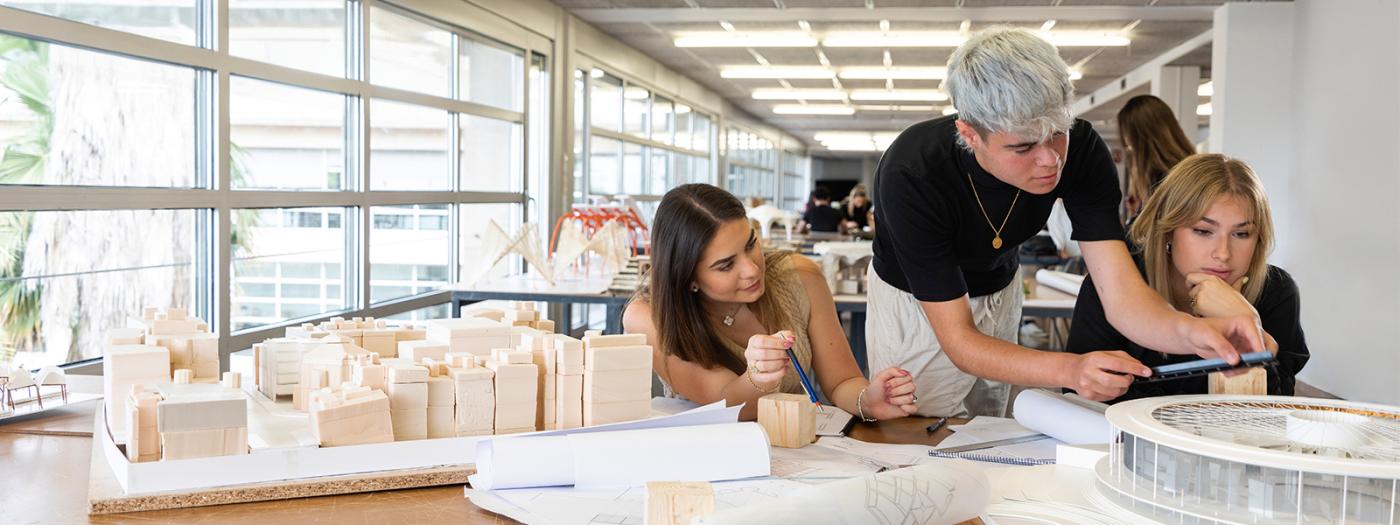To develop the capacity for critical observation and understanding of form through drawing:
o Identify complex geometries, recognize them in singular works of architecture, analyze them, and represent them in the different systems (dihedral, conic, and axonometric).
To understand the laws of sunlight and apply them to specific temporal and architectural scenarios through drawing.
To be sensitive to the relationships between architecture and place: form, space, structure, light and material.
Reflect on the usefulness of drawing and geometry, and its possibilities to apply in the project exercise:
-Identify architectural project strategies and express them through drawing, with the appropriate tools, procedures and systems of representation.
appropriate tools, procedures and representation systems.
-To know theoretical and plastic references of the history of architecture, to interpret them to produce artistic and design speeches of their own.
Discriminate the use of materials, techniques, formats and representation systems for each phase of the drawing and project process:
-Develop the capabilities of drawing as a language.
-To understand drawing as a research tool, useful in the learning and decision making process.
-To link drawing to the daily exercise of recording, analysis and proposal.
Involvement and debate in group work. In individual work: initiative for experimentation, increase of the critical sense and the ability to evaluate processes and results
to evaluate processes and results, both their own and those of others.
1.1: Introduction to artistic and geometric drawing as an analytical, communicative and projective process. Short practical exercises
2.1: Form and Place 1: Beginning of the 1st work: presentation of 1st common case study (Drawing and Geometry) as a starting point. Practical exercises on the building and introduction to other relevant architectural examples.
2.2: Form and Place 2: Practical session# (classroom/in situ): In-situ analysis of comparative case study (Barcelona) and development of set of geometric forms.
geometric forms.
2.3: Form and Place
3: Practical session# (class). Individual corrections of papers. Pre-correction of the 1st paper: contents and composition of the
presentation.
3.1: Light, Material 1: Beginning of the 2nd paper: presentation of the 2nd common case study (Drawing and Geometry). Practical exercises on the building and introduction
to other relevant architectural examples.
3.2: Light, Material 2: Practical session# (class/in situ): in-situ analysis of the comparative case study (Barcelona) and development of sunlighting concepts.
3.3: Light, Material 3: Practical session# (classroom): Individual corrections of papers. Correction prior to the 2nd paper: contents and composition of presentation.
presentation.
4: MIDTERM: Presentation and correction of the first two papers.
5.1: Workshop: Introduction to the topic and format and organization. Individual analysis of the case study.
5.2: Workshop: Visit to the studied building. Analytical drawing in-situ.
5.3: Workshop: Practical Session. Presentation of the compositional scheme of the final drawing. Correction of concepts and graphic definition.
5.4: Workshop: Practical Session. Correction of final drawing in process.
5.5: FINAL EXAMINATION: Public presentation of the workshop work.
Problems and exercices.
Laboratory practicals
Seminars
Self Paced Learning
Project based learning
Peer Instruction
Real events
Challenge based learning
Master class
Exams
Internal / external reports
Exercices, problems, interships
Projects
Group / individual presentations
Self-assessment
Class participation
Project corrections: tutorials
Jury correction
